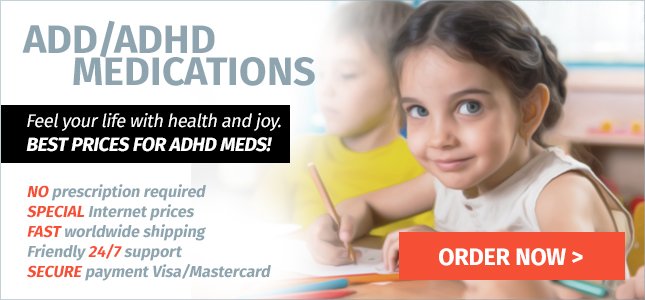ADHD is a behavioral disorder, diagnosed both in children and adults. Feature of ADHD in children is a disorder of situational adaptation, characterized by hypersensitivity, impulsivity and violation of attention in various situations.
ADHD symptoms in adults are identical to ADHD symptoms in children. However unlike children, adults are able to adapt to ADHD. So, this neurological disorder does not affect the social activity of adults as negative as the social activity of children.
To treat ADHD non-stimulant ADHD meds and meds, stimulating central nervous system (CNS) can be prescribed to children and adults. Given that ADHD in adults is very often associated with other neurological disorders (for example, insomnia), adults can be prescribed ADHD meds in combination with other meds.
List of ADHD meds
ADHD meds for adults and kids are produced by several pharmaceutical companies. So, at regional pharmaceutical markets they can go on sale under dozens of different trade names. It should be noted that ADHD meds for adults and ADHD meds for kids may contain the same pharmaceutical ingredient, the only differences between them are dosage form and price.
For example, a new ADHD medication Quillivant, containing an active substance Methylphenidate went on sale in 2012. Indication for the use of oral suspension Quillivant is ADHD treatment in children from 6 up to 12 years. Although, oral solution Methylin which also contains Methylphenidate is sold at pharmacies for over 10 years and is prescribed for ADHD treatment not only in children over 6 years but also adults.
Oral ADHD meds, containing Methylphenidate (tablets, capsules) are also available for sale under trade names: Metadate, Concerta, Equasym and Ritalin. Noteworthy that Methylphenidate is one of the few ADHD meds for children and adolescents, which is available in transdermal patches and chewing tablets (Daytrana patch and Daytrana pills).
Hypersensitivity to pharmaceutical substance Methylphenidate can be diagnosed in adults and children. So, they can be prescribed other ADHD meds. Lisdexamfetamine can be prescribed as an alternative to one of the most prescribed ADHD medicine Methylphenidate.
Like Methylphenidate, Lisdexamfetamine is a CNS stimulant. Therapeutic efficiency of these ADHD meds is almost identical. However, unlike to Methylphenidate which is available in different dosage forms, Lisdexamfetamine is produced only in capsules for oral administration.
Lack of alternative dosage forms of Lisdexamfetamine significantly limits its use in pediatric patients. After all, if a child refuses using usual oral ADHD meds, parents should discuss with the doctor the possibility of replacement oral tablets and capsules for chewing pills, solution, suspension or transdermal patch.
If a child or adult experiences nervousness, insomnia or other side effects from CNS when using CNS stimulants for ADHD treatment, the taken meds can be replaced by non-stimulant ADHD meds. The most modern non-stimulant medicine for ADHD treatment is Atomoxetine. This medicine is available for sale for over 10 years under trade name Strattera.
Advantage of Atomoxetine over CNS stimulants is that the risk of headache and insomnia is almost absent after its oral use. However, like in the CNS stimulants, side effect of non-stimulant ADHD meds can be a decreased appetite. So, they should not be used in children, adolescents and adults with anorexia.
Regardless of patient’s age, it is necessary to assess the functions of cardiovascular system before to start using ADHD meds. If cardiovascular side effects (tachycardia, increased blood pressure) occur in the period of using ADHD meds, one should stop ADHD treatment and consult a health care professional.
